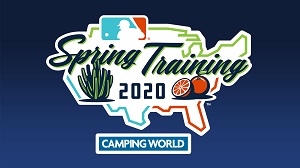Three-way LF battle shaping up for Rockies
This browser does not support the video element.
DENVER -- The Rockies envisioned Ian Desmond as the ultimate moving part when they signed him before the 2017 season. In '20, if left-handed-hitting outfielders Raimel Tapia and/or Sam Hilliard come through, could he serve the role of a platoon player in left field?
Desmond, 34, signed his five-year, $70 million contract with an eye toward first base. But after the start to his Rockies career was sidetracked by a fractured left hand, he was bounced to left field. From there, he has gone to first base, back to left field, to shortstop for a game or two, to center field (in an ambitious experiment last season) and back to left field.
Indeed, left is a question.
As far as the daily lineup goes, the Rockies figure to have a strong top four in right fielder Charlie Blackmon, shortstop Trevor Story, center fielder David Dahl and third baseman Nolan Arenado. Other positions may have question marks about offensive production, but at least no one is asking who. First baseman Daniel Murphy will need to recover from an injury-filled disappointment in the first year of a two-year, $24 million deal, and second baseman Ryan McMahon hopes to build on the power and selectivity he showed in his first full season.
But left figures to be a true competition in Spring Training. Offensive production, whether from one or several players, would lengthen that lineup. Late last season, Desmond waxed philosophical.
“When I signed, I said I was willing to do whatever to help the team win -- sometimes I don't know if they're utilizing me to make a team better or they’re trying to hide me,” he said with a slight chuckle. “But either one, I feel like I’m doing the best I can in both scenarios, so that’s not going to change. I'm just going to keep fighting.”
Desmond’s price tag ($15 million in 2020) and minus-3.4 Wins Above Replacement (per Baseball Reference) over three seasons have combined to make him one of the most maligned players to wear purple pinstripes in recent years, despite the fact that his baseball smarts and occasional big plays helped the team during postseason trips in 2017 and '18.
Exacerbating the issue was the decision last year to move Blackmon to right -- to save wear and tear -- and replacing him with the older Desmond, who struggled in the spacious center field at Coors. But after abandoning the experiment and putting Dahl in center in July, it is possible Rockies manager Bud Black has found a role for Desmond.
Against left-handed pitching, the right-handed-hitting Desmond hit .297 and a .977 OPS in 198 plate appearances, as well as 14 of his 20 home runs.
This browser does not support the video element.
“It depends on who potentially is swinging the bat well," said Black. "In Desi’s case, when we started playing well in May and into June, he got close to .300 and we saw some production there.
“But the more good players you have playing well, that’s a good thing, right? The hard choice is what you want.”
Interestingly, Desmond, who spent the early portion of his career as a shortstop, had four assists in 44 games in left. Tapia and Hilliard are most comfortable in center, but have experience in all three positions.
Can Desmond, who compiled a .274 first-half average, stave off competition for regular starts in 2020?
Or will Desmond face lefties? That’s possible if Tapia, 26, who played better during stretches of consistent playing time, can justify a platoon. While Tapia’s averages were essentially the same (.274 vs. righties, .277 vs. lefties), his on-base and slugging percentages were higher against right-handed pitching.
This browser does not support the video element.
Tapia fanned 100 times in 426 at-bats and walked just 21 times, figures that must improve. He has solid speed with the ball in play, as evidenced by his inside-the-park homer against the Phillies on April 20. But he’s not a daring basestealer (9-for-12 last season).
And the X-factor is Hilliard, 26 on Feb. 21, who recorded seven homers, four doubles, two triples and 13 RBIs in 87 plate appearances after his August callup.
This browser does not support the video element.
Hilliard’s numbers in a small sample were platoon-proof -- .974 OPS vs. righties, 1.117 vs. lefties. If he can enter the season with the same power and trim strikeouts, he just might render platoon talk meaningless. It's also worth noting that Hilliard has eye-popping speed for a man who stands at 6-foot-5 and 238 pounds -- he stole 22 bases in Triple-A prior to his promotion.
